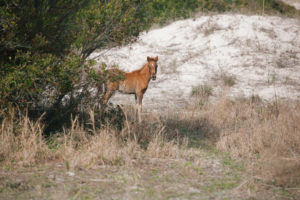Camping and Hiking Georgia

In every direction from Atlanta, hiking, boating and camping await those who need a breath of fresh air
STORY: Gresham Cash
PHOTOS: Jodi Cash
Atlanta, “The City of Trees,” has no shortage of beautiful parks and verdant trails. But for those who wish to break from the confines of our urban forest, Georgia offers more than 60 state parks, 867,000 acres of national forest and thousands of miles of hiking trails. And a considerable portion of these parks allow camping—and many for free.
Striking out in any cardinal direction from Atlanta provides a wide range of outdoor experiences. Depending on how much you enjoy sweating or shivering, hills or flats, water or forest, Georgia provides a generous collage. Here are some options for Atlantans looking to hit the trail:
North
After a short drive northeast, the misty blue Appalachian Mountains loom against the sky. They are more delicate and aged than most mountains in the U.S. Considering the area receives nearly as much rain as the Pacific Northwest, they are densely forested and abound with a wide array of salamanders, trees, flowers, fish and migratory birds—even black bears.
The Appalachian Trail in Georgia offers 78.6 miles of relatively challenging hiking bordered by idyllic campsites. Due to the hilly nature of the Appalachians in North Georgia, trails feature grueling direct ascents or constant switchbacks. But many sections offer tough hikes that result in picturesque mountaintop campsites or flush riparian grottoes hemmed by dark rhododendron and mountain laurel.
For those who wish to avoid human contact, North Georgia has other rural but well-established trails. The Benton MacKaye Trail and the Bartram Trail cover sections of the Appalachians the Appalachian Trail bypasses. Camping is permitted in well-established campsites along all of these trails.
East
Many of Georgia’s beautiful lakes and rivers are accessible from Atlanta after only a few hours’ drive north on I-85 or east on I-20. Georgia shares three major man-made lakes with South Carolina: Hartwell Lake, Richard B. Russell Lake and J. Strom Thurmond Lake, which is also known as Clarks Hill Lake and has the distinction of being the largest Corps of Engineers lake east of the Mississippi with 71,000 acres.
To experience the serenity of lakeside camping, Tugaloo State Park and Richard B. Russell State Park offer campsites. One of the best ways to explore the enormity of these lakes is by boat, canoe or kayak.
West
The Chattahoochee River is Atlanta’s source of life. Babbling through the Appalachians and rolling across Georgia’s Piedmont into the city, the river is most often explored in its crystal-clear mountain form or by tubing in the cold water below the Buford Dam and Lake Lanier. One of the newest state parks, Chattahoochee Bend, offers a glimpse at the dark red water and geological influence of the river below the city.
With 2,910 acres and 5 miles of riverfront, Chattahoochee Bend is crisscrossed by quiet trails that climb gentle hills and traverse the river’s sandy floodplain. Camping options range from R.V. sites to limited backcountry permits.
South
For the observant traveler driving south out of Atlanta, the Appalachians disappear beneath the horizon. The rolling terrain of the Piedmont collides with Georgia’s ancient seashore at the sandy hills of the Fall Line and levels onto the Coastal Plain that continues into South Carolina, Florida and Alabama. At Georgia’s southeastern most corner, a glimpse at an older world is available at Cumberland Island National Seashore.
About 9,800 acres of designated wilderness preserve the unique habitat of East Coast barrier islands and are traversable in their unspoiled magnificence on Cumberland Island.
The trip to the island begins with a ferry from the small naval town of St. Marys. After crossing vast marshlands, visitors are deposited on an island devoid of vehicular traffic and with a limited number of campsites best reserved online in advance. Make sure to bring a camera for photo opportunities with the island’s wild horse population.
Miles of trails wind through quavering saw palmetto and deep green live oaks. Around the island are glimpses of a past existence when the likes of the Carnegies vacationed on the island. Ruins of old mansions, some still standing and preserved, are scattered across this beautiful barrier island.














